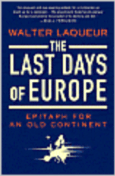 Reviewed by James L. Abrahamson, Internet Article Reviews Editor
Reviewed by James L. Abrahamson, Internet Article Reviews Editor
The Last Days of Europe: Epitaph for an Old Continent. By Walter Laqueur (New York: St. Martin’s Press, 2007. Pp. x, 243. $25.95 cloth).
Since the end of World War II experts have opined on Europe’s future, offering predictions that with time swung widely between extremes. When Europe miraculously rose from the war’s ashes, some soon felt the Continent likely to become a new world power, displacing even the United States. When the economic miracle lost its momentum, experts began describing Europe as aged, about to enter its historical twilight, or even suffering from what Jean-Claude Chesnais called the Revenge of the Third World. Unconcerned when the drive toward Europe’s unification stalled in 2005, Mark Leonard explained Why Europe Will Run the 21st Century, not an era of a new imperialism but one in which the world adopted Europe’s superior values and ways.
Where economists and strategists eagerly go, historians typically fear to tread: predicting the future, at least in print. Not so Walter Laqueur, who feels that the Europe of his birth, the one he has studied and written about for the past forty years, “is in the process of disappearing.” Though not certain what will replace it, he finds that Europe’s “general direction seems to be clear, and it is not one that fills [his] heart with great joy.” (x) The author of twenty books on Europe, terrorism, and Jewry, Laqueur now heads the International Research Council of the Center for Strategic and International Studies in Washington, DC. Having spent his adult life moving between Europe and the United States, Laqueur’s assessment deserves careful attention.
Pausing occasionally to focus on the unique situations in Europe’s major nations, Laqueur builds his argument by weaving together the influence of several major developments: the decline of Europe’s fertility rate below replacement levels; the presence of large, diverse, and unhappy Muslim populations; Europe’s expensive welfare services; and its stalled political integration.
Summarizing what demographers have long known but politicians until recently ignored, Laqueur points out that Europe’s fertility rate has fallen well below the rate (2.2) sufficient to maintain its present population. By 2050, the population of Europe (including Russia) will likely decline by 130 million, with the rate of loss picking up in the last half of the century. Down to 1.37 children per woman by 1960, and lower still in Russia, Italy, and Spain, the rate may soon fall below the level at which historically no society has ever recovered. Nor do crude numbers tell the whole story. Declining fertility also means an aging population and shrinking work force, which may lead to economic decline as well.
As the numbers of ethnic Europeans tumble, such is not the case with its growing immigrant populations. Even so, to restore a suitable age balance, Europe would need another 700 million immigrants by 2050. Laqueur’s researches reveal, however, that ethnic Europeans are none too pleased with many of the immigrants it already has. Though Europe successfully accommodated those who arrived immediately after World War II, the more recent arrival of large numbers of Muslims – Pakistanis, North Africans, Kurds, and Turks, many of them illegal – has posed serious problems. Perhaps because the Muslims now benefit from Europe’s generous social welfare programs (housing, healthcare, payments to the unemployed), Laqueur speculates, too few have learned their new country’s language, taken advantage of its educational system, learned a skill, and found jobs.
Though there are individual success stories, most Muslims concentrate in ghettos – where their imams are pleased to keep them – and the young especially have become alienated and filled with hatred toward their European homeland. Even in the second and third immigrant generations, assimilation proceeds too slowly, if at all, to prevent gangs, riots, and a growing risk of Islamic terrorism. Nor has European fascination with multiculturalism and cultural relativism helped; both concepts push countries with large Muslim populations in the direction of becoming tribal societies, as Muslims reject European standards and demand to live under sharia law, which local authorities sometimes too readily accommodate.
Declining fertility amongst ethnic Europeans, an aging population, and immigrants unwilling or unable to achieve a respected place in a modern society and help it grow combine to raise questions about Europe’s ability to continue financing its expensive social welfare systems. Making the ultimately necessary large increases in taxes or deep cuts in programs seem certain to create great resentment among both native and immigrant populations, further adding to social tension.
Europe’s path toward more complete political integration stalled in 2005, when the Netherlands and France rejected the proposed European Union (EU) constitution and disrupted efforts to develop a common foreign policy and build a capable European armed force. The EU’s pathetic reaction to problems in Bosnia, Kosovo, and the Middle East has demonstrated that its reliance on soft power represents a worldview that Laqueur described as “far detached from realities.” (121) He also senses that Europeans are losing their former cooperative spirit as nations increasingly look inward to their unique national interests. Predictions of the EU becoming a “world player” seem remote indeed. (201)
Laqueur closes his book with attention to likely criticisms of his argument. There is no reason, he maintains, to think that Europe’s fertility rate will suddenly improve and maintain high levels. Nor does he see much hope that Europe will soon recover its previous dynamism and economic growth. More likely its trade will suffer from the economic booms in China and India. Its Muslims, with many internal ethnic and religious divisions, have shown little interest in becoming a political force, and Belgium’s experience does not bode well for the emergence of successful bi-national states joining ethnic Europeans in some areas with Muslims in others. The Continent’s varied efforts to assimilate Muslims through their educational systems have so far produced meager results, and hoping to appease the imams by introducing religious education would likely make the long-term social situation worse.
Laqueur ends with a call to Europeans to face their challenges, openly debate responses to their problems, determine what kind of Europe they want to be. “The age of delusions is over,” he concludes. Whatever Europe eventually emerges “will be quite different from the one we have known.” (226)![]()

Following graduation from West Point (1959), James L. Abrahamson began a 27-year career in the U.S. Army, during which he earned a master’s degree from the University of Geneva (1964) and a Ph.D. from Stanford University (1977).
